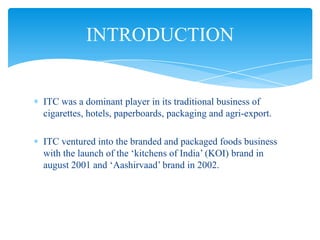ItcŌĆÖs foray into convenience food market
- 1. ITCŌĆÖs ŌĆ£ Convenience Food MarketŌĆØ Presented By: Sumit Pranjal sanyog Vimalesh Akanksha Rohit saxena
- 2. Abstract ’üČ ITC Ltd. entered the convenience food market in India in 2003. ’üČ It introduced its convenience food products under two brand names, 'Kitchens of India' and 'Aashirvad', for the upmarket and middle-class segment respectively. ’üČ The caselet titled 'ITC's Foray into Convenience Food Market' examines ITC's launch and pricing strategy for these products in the country. ’üČ The caselet also gives an overview of the processed food industry in India. ’üČ ITC's use of retorting technology to ensure a long shelf life for their processed food products is also touched upon.
- 3. Issues: ’üČ The emergence of the convenience food industry in India ’üČMarket segmentation for convenience food ’üČ Use of technology to ensure long shelf life for convenience food products ’üČITC was a dominant player in its traditional businesses of cigarettes, hotels, paperboards, packaging and agri-exports. ’üČITC ventured into the branded and packaged foods business with the launch of the 'Kitchens of India' (KOI) brand in August 2001 and the 'Aashirvaad' brand in 2002. ’üČ By entering the food business, ITC aimed at leveraging on its proven strength in the hospitality industry, packaging, and sourcing of agricultural products...
- 4. INTRODUCTION ITC was a dominant player in its traditional business of cigarettes, hotels, paperboards, packaging and agri-export. ITC ventured into the branded and packaged foods business with the launch of the ŌĆ×kitchens of IndiaŌƤ (KOI) brand in august 2001 and ŌĆ×AashirvaadŌƤ brand in 2002.
- 5. CONTŌĆ”.. In June 2003 ,ITC entered the convenience food market , launching ready- to-meal(RTEM), under the ŌĆ×kitchens of IndiaŌƤ brand name. The USP of these product is that absolutely no preservatives have been added, but the self- life of these food is close to a year.
- 6. SEGMENTATION OF KOI Geographic ŌĆō Urban Area Demographic- Age: 25+, upper class, Tourists, NRIs, Time pressed family Psychographic ŌĆō Lifestyle -Personality: Extroverts, low dogmatism Behavioral -Benefit: Less time consume -User rate: Medium users
- 7. SEGMENTATION OF AASHIRVAAD Geographic ŌĆō Urban Area Demographic- Age: 25+, upper class, meddle class, Time pressed family Psychographic ŌĆō Lifestyle -Personality: Extroverts, low dogmatism Behavioral -Benefit: Less time consume -User rate: High users
- 8. MOTIVATION & GOAL Positive Motivation: Ready ŌĆōto-eat meals, ŌĆ×Quick to heat, Delight to eatŌƤ Rational Motives: Benefit to saving time
- 9. PERSONALITY TRAIT THEORY ’é¦ Innovativeness: High ’é¦ Dogmatism: Low ’é¦ Social Character: Inner directed ’é¦ Need for cognition : High NC ’é¦ Optimum Stimulation Level : High
- 10. Analysing Positioning Strategy LOGO: ’üČThe logo of the brand has a wooden plank with Kitchens of India written on it in a stylized font ’üČStylized India map in black and golden borders in the corner of the plank, it has also got Kitchens of India written on it. ’üČThese elements together give a royal , exclusive and warm feeling to the brand. ’üČThe main reason behind this may be that the product was initially developed keeping in mind the export markets, where evoking India and royalty centric emotions would have been necessary.
- 11. Cont. COLOUR ŌĆō Mainly light golden colour is used to give a royal Indian feel to the brand. IMAGES ŌĆō The images used are very high quality images of Tasty food in precious/exquisite looking utensils. GRAPHICS ŌĆō The graphics used are those which can be described as traditional Indian art used for crafting sides and borders, usually found in Indian palaces and forts. This is also done to provide an India centric identity.
- 12. Cont.. FONTS ŌĆō Stylised fonts which add to the India centric appeal. Moreover they also evoke association with ITC. PACKAGING The outer packaging has been done In good quality hard paper to preserve that ŌĆ£authenticŌĆØ touch prominent with the brand.
- 13. Cont. NAMES The names of the dishes have also been wisely chosen to reflect the positioning which is ŌĆ£Authentic ,Tasty Indian CuisinesŌĆØ . Names are also chosen to reflect the association with ITCŌƤs restaurants like Bukhara Dumpukht etc. in its welcome group hotels. ADVERTISEMENT The advertisements reflect the positioning well while sending strong visual stimuli to stimulate the senses and create favourable perception. The brand has come out with a range of classical music albums to appeal to consumers hearing tastes
- 14. Perceptual map Easy to use Multi-purpose cooking paste Ready to eat food(masala) High price Low price Staples(Atta &salt) Hard to use















